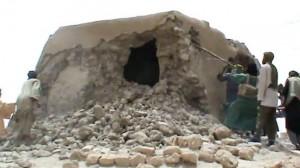By Bennett Furlow and Jeffry Halverson
 Over the past week a militant Islamist group operating in Mali called Ansar Dine has destroyed a number of Sufi mausoleums and the legendary gate of a 600-year-old mosque in the fabled city of Timbuktu. Many news reports have compared these tragic events in Mali to the destruction of the Buddhas of Bamiyan by the Taliban in 2001. There is a key difference though that could lead to dramatically different consequences—if only there were an authority capable of exploiting it.
Over the past week a militant Islamist group operating in Mali called Ansar Dine has destroyed a number of Sufi mausoleums and the legendary gate of a 600-year-old mosque in the fabled city of Timbuktu. Many news reports have compared these tragic events in Mali to the destruction of the Buddhas of Bamiyan by the Taliban in 2001. There is a key difference though that could lead to dramatically different consequences—if only there were an authority capable of exploiting it.
In the case of Mali, the Islamist extremists are destroying revered Muslim sites, whereas the Taliban destroyed remnants of a Buddhist site. While equally abhorrent and alarming, there hasn’t been a significant Buddhist population in Afghanistan for hundreds of years. In contrast, Ansar Dine is attempting to impose its control on (or win over) a population that deeply reveres the sites they are destroying.
There is little doubt that many in Afghanistan took pride in the giant Buddhas of Bamiyan as a part of their culture and heritage. Indeed, those Buddhas survived Muslim rule for over a millennium before they were deemed idolatrous and destroyed. However, attacking sacred Muslim sites in Muslim-majority-Mali, even if they are “Sufi,” hardly seems a strong strategy for pacifying resistance to their nascent rule.
Then again, Saudi Arabia has been destroying irreplaceable archeological and sacred sites in cities such as Mecca and Medina for years. No one, not even UNESCO, has prevented them from doing so. For example, the house of the first caliph of Sunni Islam, Abu Bakr, was bulldozed to make room for the Mecca Hilton Hotel.
To give some historical context to events in Mali, there was an influx of arms after the Libyan civil war, especially among the Tuaregs. The Tuaregs are a Berber people who mainly live in Mali and Niger, but also within the state borders of Algeria and Libya. A significant number of Tauregs aspire to see the area of northern Mali, known as Azawad, under Taureg control as an independent state.
In January 2012, a Tuareg separatist movement, known as the National Movement for the Liberation of Azawad (MNLA), began a rebellion against Mali’s central government. However, there was a military coup d’état in Mali due to a mishandling of this rebellion. The military then suspended the constitution and instability throughout Mali ensued (they later reinstated the constitution). During this period, the Tuareg rebels captured the north’s three major cities, including historic Timbuktu.
The militant Islamist Ansar Dine (“Defenders of the Faith”) formed in February or March, seeking to implement sharia across Mali, both in Azawad and elsewhere. Clearly, Ansar Dine was capitalizing on the conflict between the Tuaregs and the government as an opportunity to realize its radical goals. Both MNLA and Ansar Dine are opposed to the central government, but for different ends. Ansar Dine wants a united Islamic Mali under sharia whereas MNLA want an independent and largely secular Tuareg state.
The destruction of the sacred sites in Timbuktu occurred in this context of political upheaval and the struggle to impose a particular identity on contested territory. Unlike the Wahhabi movement (e.g., see its entire history) or Protestant iconoclastic uprisings in Europe, religious extremists tend to destroy the relics or shrines of “rival” or “pagan” religious traditions. For example, a Christian tourist set fire to the sacred al-Aqsa mosque in Jerusalem in August of 1969 (hoping to bring on the Second Coming).
Timbuktu, however, has a long and rich Islamic history. It was a major Islamic center for learning and scholarship well into the sixteenth century. Much of Timbuktu’s modern economy is based on tourism because of this rich history. People travel to the city for pilgrimage or to simply see these historic sites.
Accordingly and put bluntly, Ansar Dine’s irreparable destruction was deeply and tactically stupid. Obviously, their control over Timbuktu is recent and hardly stable. Alienating the locals by destroying sites beloved by the Muslims there (not to mention Muslims and cultural enthusiasts worldwide) and devastating the fragile economy of the city in the process is unimaginably bad strategy. It’s a critical moment to act against Ansar Dine and marginalize them from the political scene. The question is who can legitimately do so?
The central government in Mali remains flux right now, which makes acting against Ansar Dine all the more difficult. A presidential election scheduled for April was put on hold after the military coup. And while there is an acting president, his power and position are nominal, especially in the wake of rebel gains.
Understanding that there are stability issues at play in Mali, there is clearly a strategic communication opportunity to capitalize on Ansar Dine’s atrocity. Properly exploited, these events could be used to severely damage their hand in the politics of the future. Unfortunately there seems to be no force capable of acting. The central government is weak, the Tuaregs are rebels, and the military—having just staged a coup—lacks the trust of the people. Ansar Dine has committed a strategic blunder, but they may have done so at the best possible time.


